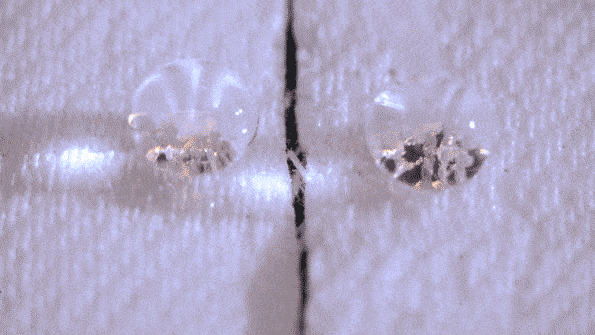MIT researchers have developed a water repellent coating for natural fabrics that is more effective – and less harmful - than existing coatings.

Coated repellent surface (left) and an untreated one (right). (Varanasi and Gleason research groups)
The new solution is said to eliminate the need for a second processing stage commonly used to produce water repellent fabrics, and has proven its durability in tests.
The new findings are described in Advanced Functional Materials, in a paper by MIT professors Kripa Varanasi and Karen Gleason, former MIT postdoc Dan Soto, and two others.
Because of the way they accumulate in the environment and in human body tissue, the US Environmental Protection Agency (EPA) is in the process of revising regulations on the long-chain polymers that have been the industry standard for water resistant materials.
The coatings currently used to make fabrics water repellent generally consist of long polymers with perfluorinated side-chains. Shorter-chain polymers are less hydrophobic than longer-chain versions. Existing coatings are also liquid-based, so the fabric has to be immersed in the liquid and then dried out, which can clog all the pores in the fabric and make them less breathable.
That requires a second manufacturing step in which air is blown through the fabric to reopen pores, adding to the manufacturing cost and undoing some of the water protection.
Research has shown that polymers with fewer than eight perfluorinated carbon groups do not persist and bioaccumulate nearly as much as those with eight or more, which are used commonly.
The MIT team combined a shorter-chain polymer that confers some hydrophobic properties and has been enhanced with some extra chemical processing; and a coating process called initiated chemical vapor deposition (iCVD), which was developed by co-author Karen Gleason and her colleagues.
The iCVD coating process produces a very thin, uniform coating that follows the contours of the fibres and does not lead to any clogging of the pores, which eliminates the need for the second processing stage to reopen the pores.
“The biggest challenge was finding the sweet spot where performance, durability, and iCVD compatibility could work together and deliver the best performance,” said Soto.
https://www.theengineer.co.uk/uk-coating-innovation-makes-a-splash-for-smartphones/
Prof Varanasi, an associate professor of mechanical engineering, said the process works on fabrics including cotton, nylon, linen, and non-fabric materials such as paper.
As well as water, the coated fabrics have been subjected to liquids including coffee, ketchup, sodium hydroxide, and various acids and bases - and have repelled all of them.
The coated materials have been subjected to repeated washings with no degradation of the coatings, and also have passed severe abrasion tests, with no damage to the coatings after 10,000 repetitions. Eventually, under severe abrasion, the fibre will be damaged, but the coating won’t, said Varanasi.
The team plans to continue working on optimising the chemical formula for the best possible water-repellence and hopes to license the patent-pending technology.





April 1886: the Brunkebergs tunnel
First ever example of a ground source heat pump?